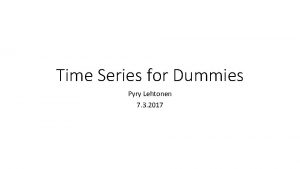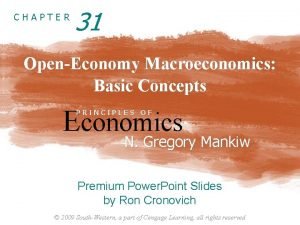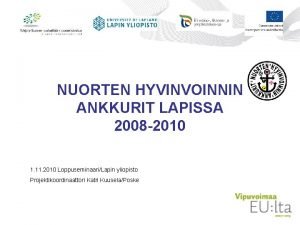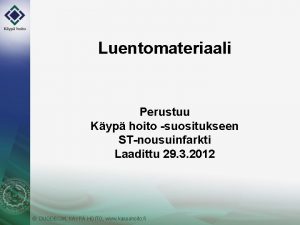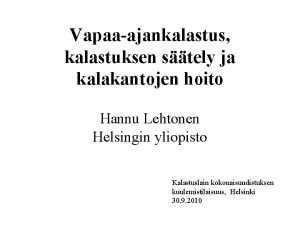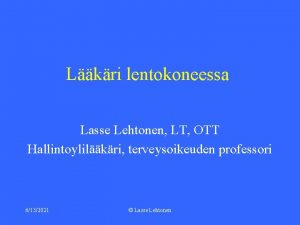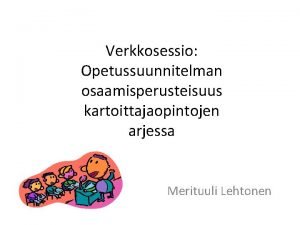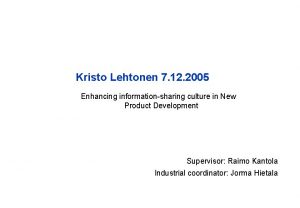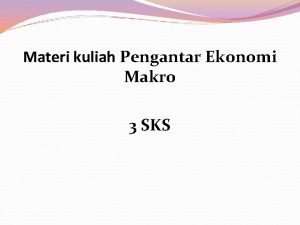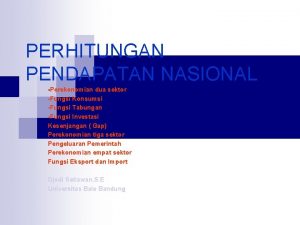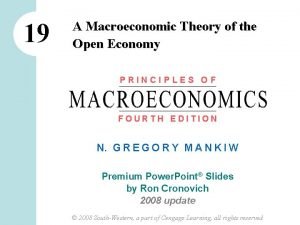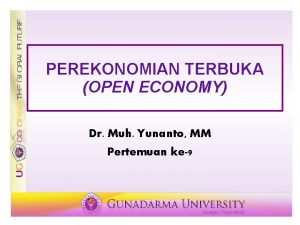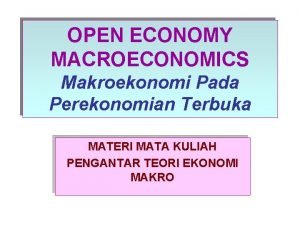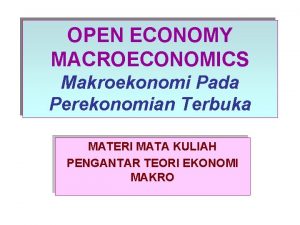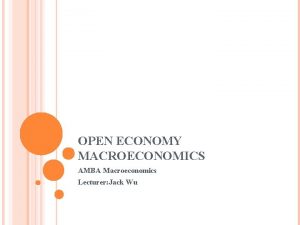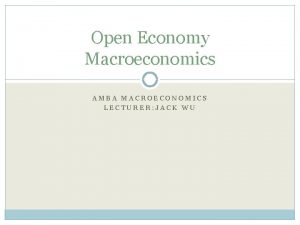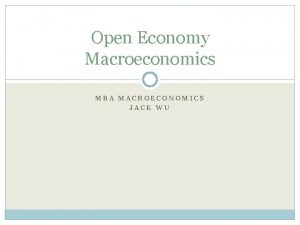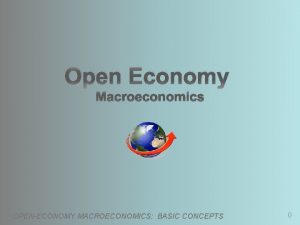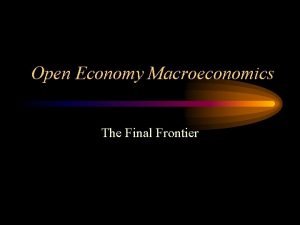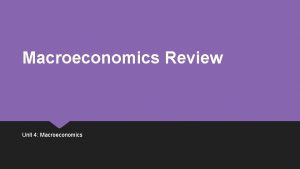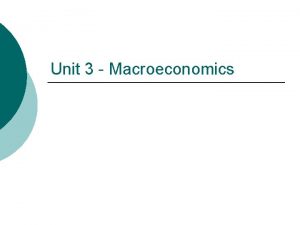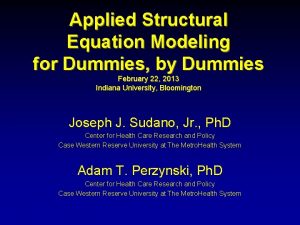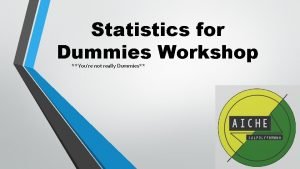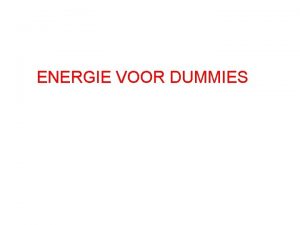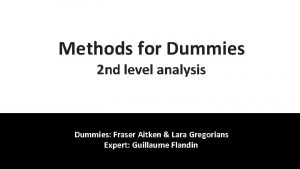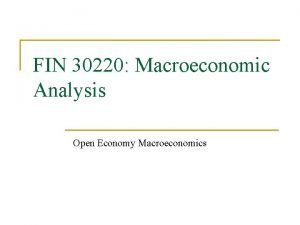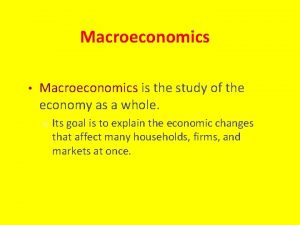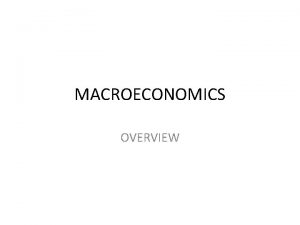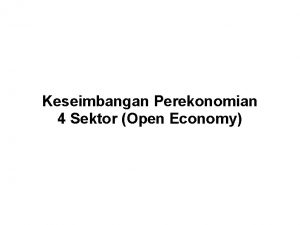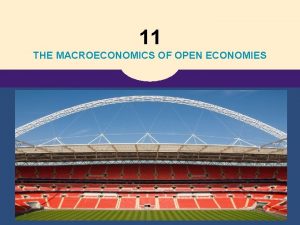Open Economy Macroeconomics for Dummies Pyry Lehtonen IScurve

















































- Slides: 49

Open Economy Macroeconomics for Dummies Pyry Lehtonen

IS-curve • IS (Investment Savings) curve Independent variable is interest rate Dependent variable is real income If r changes -> curve shifts If y changes -> movement on the shift IS-curve represents the equilibria where total savings equal to total investments (S=I) • Every level of interest rate will generate a certain level of fixed investment • Goods market equilibrium • In this course, real exchange rate Q is included in the IS curve • • • Q have effect on net exports NX

IS-curve •

LM-curve • LM (Liquidity preference and Money supply) Independent variable is real income Dependent variable is interest rate If r change -> movement on the shift If money supply change -> curve shifts The LM-curve shows the combinations of interest rates and levels of real income for which the money market is in equilibrium • Assumption in this course: openness of the economy does not affect to the supply side of the economy • Equilibrium in the (domestic) money market -> Money demand = Money supply • • •

• Monetary policy in a open economy depends on the exchange rate arrangements • Floating exchange rate -> Management of money supply • Fixed exchange rate -> Control of banking system lending (controlling domestic credit) y = income , r = interest rate, k and l are behavioral parameters When y increases, r has to increase too

Derive the aggregate demand from ISLM

Exchange rates • Cross exchange rates • Spot rate: exchange happens immediately • Forward or future rate: exchange happens in the future

• • Bid rate = buy rate Ask (or offer) rate = sell rate Bid/Ask spread is the gap between these two Supply and demand of currencies come from: • International trade • Investments (shares, estates etc. ) • Speculation (profit from buying and selling currencies)

Different Exchange Rates • Floating exchange rate • Price of the currency (relative to other currencies) is determined by supply and demand • Fixed exchange rate • Tied to another country’s currency (or gold) • Purpose is to maintain country’s currency value stable • Foreign currency trade through central bank and/or private holdings of foreign currency banned or restricted • Managed Float • Fixed rates with fluctuation bands

Balance of Payments (Bo. P) • Bo. P gives information about the flow of demand supply of the currency over any period • Current Account & Capital Account • Foreign currency reserves under fixed exchange rate • Current account surplus -> exchange rate of the currency will increase, ceteris paribus, and vice versa

Law of One Price • PPP is based on the notion of the Law of One Price (LOP) • Identical goods have the same price • Arbitrage and transaction costs • Speculation • Risky • Non-traded goods (non-tradeables) • Arbitrage is not possible

Law of One Price • In global law of one price exchange rates, tariffs and quotas should be taken into account

Purchasing Power Parity (PPP) •

Real Exchange Rate Q •

Pass-Through Effect • The exchange rate pass-through effect is the degree to which the prices of imported and exported goods change as a result of an exchange rate change • The pass-through from exchange movements to prices is usually incomplete • US exporter makes cars: 75% of inputs are priced in $, 25% in € -> 10% appreciation of the euro will lead only to 7. 5% increase in the car price in euros

Uncovered Interest Rate Parity (UIP) •

Uncovered Interest Rate Parity (UIP) •

Covered Interest Rate Parity (CIP) •

Risk Premium •

PPP in Expectations •

Dornbusch Model •

Dornbusch Model •

Dornbusch Model Slope of the RPcurve: - In the short-run, the price level is fixed, so shocks move to the nominal exchange rate and, hence, the real exchange rate

Effect of expansionary monetary policy IS = C + I + G +NX(Q)

Currency Substitution (CS) •

• • • NT curve displays the equilibrium condition in the non-tradeables sector (when Q increases, W falls) TT-curve describes the combination of Q and W that sustain zero current account balance in the long-run. Short-run excess supply (demand) are points below (above) the TT-curve. If there exists current account surplus/deficit, then there will be positive/negative accumulation of the foreign currency In the long-run equilibrium E, there is equilibrium in tradeables and non-tradeables sector with zero current account balance (no inflow/outflow of foreign currency)


Currency Substitution (CS) •


Rational Expectations (RE) •

Rational Expectations (RE) •

News Model • Concentration on the random error in forecasting the future exchange rates • News model assumes rational expectations • Some information “news” are unforeseeable, thus random error exists • In the monetary model, the exchange rate depends on relative money stocks, income and interest rates • Also expected capital gain or loss from holding the currency should be taken into account • Current level of the exchange rate depend on its expected rate of change

Risk Premium •

Risk Premium •


A General Model of the Risk Premium •

A General Model of the Risk Premium •

Mundell-Fleming Model (MF) •

MF under flexible exchange rates • Expansionary monetary policy • LM shifts right • Local interest rate lower than global -> capital outflows because of the decreased interest rate -> depreciation of the local currency • Depreciation increases net exports and IS shifts right where local interest rate equal global interest rate (Bo. P is balanced)

MF under flexible exchange rates • Expansionary fiscal policy • G increases -> IS curve shifts right • Local interest rate is above global interest rate -> capital inflow -> appreciation of domestic currency • Appreciation decreases net exports and IS shifts back where local interest rate equal global interest rate (Bo. P is balanced)

MF under flexible exchange rates • Increase in global interest rate • Capital outflow from the economy -> depreciation of currency -> Net exports increase • IS-curve shifts to right to the point where domestic and global interest rates are equal

MF under fixed exchange rates • Expansionary monetary policy • LM-Curve shifts to right -> Bo. P deficit • Government has to buy domestic currency and sell foreign currency -> decrease in money supply • Back to original equilibrium -> monetary policy do not have effect under fixed interest rates

MF under fixed exchange rates • Expansionary fiscal policy • IS-curve shifts right (G increases) • Appreciation of the exchange rate, to maintain fixed rate -> government buy foreign currency and sells domestic currency -> increase in money supply > LM-curve shifts right

MF under fixed exchange rates • Increase in global interest rate • Capital outflow • This would depreciate the domestic exchange rate • In order to keep the exchange rate stable government has to buy home currency and sell foreign currency -> decrease in money supply -> LM-curve shifts to left to the point where domestic and global interest rates are equal

Summary •




 Time series for dummies
Time series for dummies Pyry lehtonen
Pyry lehtonen Chapter 31 open economy macroeconomics
Chapter 31 open economy macroeconomics Gravity for dummies and dummies for gravity equations
Gravity for dummies and dummies for gravity equations Example of open market operations
Example of open market operations Athens and sparta were both
Athens and sparta were both 영국 beis
영국 beis Olli lehtonen luke
Olli lehtonen luke Anurag lehtonen
Anurag lehtonen Kaupallinen neuvonanto
Kaupallinen neuvonanto Reperfuusiohoito
Reperfuusiohoito Hannu lehtonen kuollut
Hannu lehtonen kuollut Lasse lehtonen lääkäri
Lasse lehtonen lääkäri Jouko kinnunen
Jouko kinnunen Merituuli lehtonen
Merituuli lehtonen Rainer lehtonen
Rainer lehtonen Kristo lehtonen
Kristo lehtonen Hannu lehtonen professori
Hannu lehtonen professori Open source circular economy
Open source circular economy Open economy
Open economy Open economy
Open economy A macroeconomic theory of the open economy
A macroeconomic theory of the open economy Open economy
Open economy Open economy adalah
Open economy adalah Open economy
Open economy Var 1721 för stormaktssverige
Var 1721 för stormaktssverige Vad är densitet
Vad är densitet Elektronik för barn
Elektronik för barn Tack för att ni har lyssnat
Tack för att ni har lyssnat Smärtskolan kunskap för livet
Smärtskolan kunskap för livet Epiteltyper
Epiteltyper Frgar
Frgar Vilka tal pekar pilarna på
Vilka tal pekar pilarna på Magnetsjukhus
Magnetsjukhus Kassaregister ideell förening
Kassaregister ideell förening Toppslätskivling dos
Toppslätskivling dos Ekologiskt fotavtryck
Ekologiskt fotavtryck Borra hål för knoppar
Borra hål för knoppar Redogör för vad psykologi är
Redogör för vad psykologi är Bris för vuxna
Bris för vuxna Mat för unga idrottare
Mat för unga idrottare Ledarskapsteorier
Ledarskapsteorier Svenskt ramverk för digital samverkan
Svenskt ramverk för digital samverkan Argument för teckenspråk som minoritetsspråk
Argument för teckenspråk som minoritetsspråk Humanitr
Humanitr Datorkunskap för nybörjare
Datorkunskap för nybörjare Antikt plagg
Antikt plagg Kontinuitetshantering i praktiken
Kontinuitetshantering i praktiken Rita perspektiv
Rita perspektiv Ministerstyre för och nackdelar
Ministerstyre för och nackdelar
